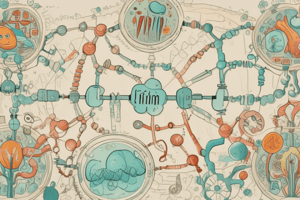Podcast
Questions and Answers
What is the primary purpose of the urea cycle in amino acid metabolism?
What is the primary purpose of the urea cycle in amino acid metabolism?
- To convert ammonia into urea for excretion (correct)
- To break down amino acids for energy
- To synthesize new amino acids
- To facilitate protein synthesis
Which process involves the removal of an amino group from an amino acid?
Which process involves the removal of an amino group from an amino acid?
- Proteolysis
- Transamination
- Deamination (correct)
- Gluconeogenesis
Which type of amino acids can be converted into glucose?
Which type of amino acids can be converted into glucose?
- Glucogenic amino acids (correct)
- Ketogenic amino acids
- Non-essential amino acids
- Essential amino acids
What is a consequence of phenylketonuria (PKU)?
What is a consequence of phenylketonuria (PKU)?
Which of the following statements about amino acids is incorrect?
Which of the following statements about amino acids is incorrect?
Which hormone is primarily responsible for promoting amino acid uptake in cells?
Which hormone is primarily responsible for promoting amino acid uptake in cells?
Which amino acid is a precursor for serotonin?
Which amino acid is a precursor for serotonin?
Which type of amino acid is leucine categorized as?
Which type of amino acid is leucine categorized as?
Flashcards are hidden until you start studying
Study Notes
Overview of Amino Acid Metabolism
- Amino acid metabolism involves the processes of breaking down proteins into amino acids and utilizing these for various physiological functions.
- Amino acids can be categorized into essential (must be obtained from diet) and non-essential (can be synthesized by the body).
Key Processes
-
Proteolysis
- Breakdown of proteins into peptides and amino acids.
- Catalyzed by proteolytic enzymes (proteases).
-
Amino Acid Catabolism
- Conversion of amino acids into intermediates for energy production or biosynthesis.
- Involves:
- Deamination: Removal of amino group, converting amino acids into keto acids.
- Transamination: Transfer of amino group to a keto acid, forming a new amino acid.
-
Urea Cycle
- Primary pathway for the removal of excess nitrogen from amino acids.
- Converts ammonia (toxic) into urea, which is excreted in urine.
Key Metabolic Pathways
-
Glucogenic Amino Acids
- Can be converted to glucose via gluconeogenesis.
- Examples: Alanine, Glutamine, and Aspartate.
-
Ketogenic Amino Acids
- Can be converted to ketone bodies.
- Examples: Leucine, Lysine.
Regulation of Amino Acid Metabolism
- Controlled by hormones (insulin, glucagon) and nutritional states.
- Influenced by factors such as pH, energetic needs, and substrate availability.
Functions of Amino Acids
- Protein synthesis: Building blocks for structural proteins and enzymes.
- Precursor molecules:
- Neurotransmitters (e.g., Tyrosine → Dopamine).
- Hormones (e.g., Tryptophan → Serotonin).
- Metabolic intermediates: Participating in TCA cycle (e.g., Aspartate → Oxaloacetate).
Disorders Related to Amino Acid Metabolism
- Phenylketonuria (PKU): Deficiency in phenylalanine hydroxylase, leading to accumulation of phenylalanine.
- Maple Syrup Urine Disease: Deficiency in branched-chain ketoacid dehydrogenase, affecting the breakdown of leucine, isoleucine, and valine.
Nutritional Aspects
- Balanced intake of essential amino acids is crucial for health.
- Protein-rich foods include meat, dairy, legumes, and nuts.
- Supplementation may be necessary for specific populations (e.g., athletes, vegetarians).
Summary
- Amino acid metabolism is vital for energy production, biosynthesis, and nitrogen balance in the body.
- Understanding this metabolic pathway is important for nutritional planning and addressing metabolic disorders.
Amino Acid Metabolism Overview
- Amino acids are building blocks for proteins and play many roles in the body.
- Essential amino acids must come from the diet, while non-essential amino acids can be synthesized by the body.
Key Processes
- Proteolysis breaks down proteins into amino acids.
- Catalyzed by enzymes called proteases.
- Amino Acid Catabolism converts amino acids into intermediates for energy production or biosynthesis.
- Involves deamination (removes amino group) and transamination (transfers amino group).
- Urea Cycle removes excess nitrogen from amino acids.
- Converts toxic ammonia into urea, which is excreted in urine.
Key Metabolic Pathways
- Glucogenic Amino Acids can be converted into glucose.
- Examples include alanine, glutamine, and aspartate.
- Ketogenic Amino Acids can be converted into ketone bodies.
- Examples include leucine and lysine.
Regulation of Amino Acid Metabolism
- Influenced by hormones like insulin and glucagon, and nutritional states.
- Factors like pH, energy needs, and substrate availability also influence amino acid metabolism.
Functions of Amino Acids
- Protein synthesis is the most important function, building structural proteins and enzymes.
- Precursor molecules for neurotransmitters (e.g., tyrosine to dopamine) and hormones (e.g., tryptophan to serotonin).
- Metabolic intermediates, participating in the TCA cycle (e.g., aspartate to oxaloacetate).
Disorders Related to Amino Acid Metabolism
- Phenylketonuria (PKU): Deficiency in phenylalanine hydroxylase leads to phenylalanine buildup.
- Maple Syrup Urine Disease: Deficiency in branched-chain ketoacid dehydrogenase, affecting breakdown of leucine, isoleucine, and valine.
Nutritional Aspects
- Balanced intake of essential amino acids is crucial for health.
- Protein-rich foods include meat, dairy, legumes, and nuts.
- Supplementation may be necessary for specific populations like athletes or vegetarians.
Summary
- Amino acid metabolism is essential for many vital functions in the body.
- Understanding this pathway is important for both health and nutritional planning.
Studying That Suits You
Use AI to generate personalized quizzes and flashcards to suit your learning preferences.



